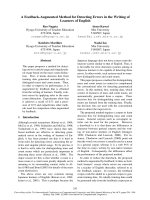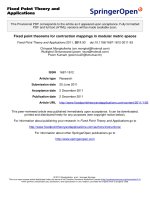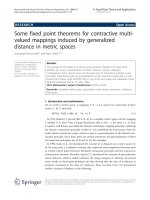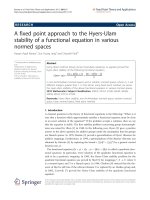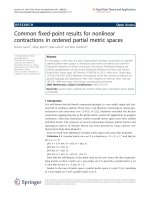Báo cáo toán học: "A Fixed Point Theorem for Nonexpansive Mappings in Locally Convex Spaces" ppt
Bạn đang xem bản rút gọn của tài liệu. Xem và tải ngay bản đầy đủ của tài liệu tại đây (104.62 KB, 7 trang )
Vietnam Journal of Mathematics 34:2 (2006) 149–155
A Fixed Point Theorem for Nonexpansive
Mappings in Locally Convex Spaces
Ha Duc Vuong
Ministry of Education and Training, 49 Dai Co Viet, Hanoi, Vietnam
Received February 22, 2005
Revised June 20, 2005
Abstract. In this note, first we establish a fixed point theorem for a nonexpansive
mapping in a locally convex space, then we apply it to get a fixed point theorem in
probabilistic normed spaces.
2000 Mathematics subject classification: 54H25, 90D13, 46N10
Keywords: Fixed point, nonexpansive mapping, normal structure, probabilistic n ormed
space.
1. Introduction
After the work [2] a lot of fixed point theorems for semigroups of mappings in
Banach spaces were obtained. However, for such results in locally convex spaces
up to now there is only one paper [4] with a restrictive condition : compactness
of the domain. In Sec. 2 slightly modifying the method in [3] we get a fixed point
theorem for a nonexpansive mapping in a locally convex space and apply it to
get an analogous result for probabilistic normed spaces.
2. Fixed Point Theorems
2.1. A Fixed Point Theorem for Nonexpansive Mappings in Locally Convex
Spaces
Letusfirstgivesomedefinitions.
150 Ha Duc Vuong
Definition 1. [4] Let E be a Hausdorff locally convex topological vector space
and P a family of continuous seminorms which generates the topology of E.
For any p ∈ P and A ⊂ E,letδ
p
(A) denote the p-diameter of A,i.e.,
δ
p
(A)=sup{p(x − y):x, y ∈ A}.
A convex subset K of E is said to have normal structure with respect to P if
for each nonempty bounded convex subset H of K and for each p ∈ P with
δ
p
(H) > 0, there is a point x
p
in H such that
sup{p(x
p
− y):y ∈ H} <δ
p
(H).
Definition 2. [4] Let E and P be as in Definition 1, and K ⊂ E. A mapping
T : K → K is said to be P-nonexpansive if for all x, y ∈ K and p ∈ P ,
p(Tx− Ty) ≤ p(x − y).
Definition 3. Let E and P be as in Definition 1. E is said to be strictly convex
if the following implication holds for all x, y ∈ E and p ∈ P :
p(x)=1,p(y)=1,x= y =⇒ p(
x + y
2
) < 1.
Proposition 1. Let (E, P) be a strictly convex space and p(x + y)=p(x)+
p(y),p(x) =0,p(y) =0.Thenx = λ
p
y for some λ
p
> 0.
Proof. Suppose p(x) ≤ p(y). Put x
=
x
p(x)
, y
=
y
p(y)
,thenp(x
)=p(y
)=1.
We have
2=p(x
)+p(y
) ≥ p(x
+ y
)=p(
x
p(x)
+
y
p(y)
)
= p(
x
p(x)
+
y
p(x)
−
y
p(x)
+
y
p(y)
) ≥ p(
x + y
p(x)
) − (
1
p(x)
−
1
p(y)
)p(y)
=
p(x)+p(y)
p(x)
−
p(y)
p(x)
+
p(y)
p(y)
=2.
So p(x
+y
) = 2, hence p(
x
+y
2
)=1. Since E is strictly convex, we have x
= y
.
From this it follows that x =
p(x)
p(y)
y and the proof is complete.
Theorem 1. Let C be a nonempty weakly compact convex subset of a Hausdorff
locally convex space (E,P) which has normal structure, and T : C → C a P -
nonexpansive mapping. Then T has a fixed point.
Moreover, if E is a strictly convex space, then the set FixT of fixed points
of T is nonempty and convex.
Proof. We first prove that T has a fixed point.
Denote by F the family of all nonempty closed convex subsets of C and
invariant under T , i.e.,
F = {K ⊂ C : K is a nonempty closed convex set and T (K) ⊂ K}.
A Fixed Point Theorem for Nonexpansive Mappings in Locally Convex Spaces 151
Clearly F is a nonempty family, since C ∈F. By weakly compactnees of C and
Zorn’s Lemma, F has a minimal element H.
Now we shall show that H consists of a single point. Assume on the contrary
that there exists p
o
∈ P such that δ
p
o
(H)=d>0. Since C has normal structure,
there exists z
o
∈ H such that r =sup
x∈H
p
o
(z
o
− x) <d.
Denoting D = {z ∈ H : p
o
(z − x) ≤ r for all x ∈ H}, it is easy to prove that
D is a nonempty closed convex subset in C,sincez
0
∈ D and p
o
is a convex
continuous function.
Now we show that D is invariant under T . For any z in D,wehavep
o
(z−x) ≤
r for all x ∈ H.SinceT is a nonexpansive mapping, we get
p
o
(Tz− Tx) ≤ p
o
(z − x) ≤ r,
for all x ∈ H. Hence p
o
(Tz−x) ≤ r, ∀x ∈ T (H). So we have p
o
(Tz−x) ≤ r, ∀x ∈
coT (H), because p
o
is a convex continuous function, where coT (H) denotes the
closed convex hull of T (H). Since T (H) ⊂ H, this implies
co(T (H)) ⊂ co(H)=
H. Hence T (
co(T (H))) ⊂ T (H) ⊂ co(T (H)). Thus coT (H) ∈F. From this and
the minimality of H we get
coT (H)=H and hence
p
o
(Tz− x) ≤ r, ∀x ∈ H.
So Tz ∈ D,andT (D) ⊂ D. Hence D ∈F. By the minimality of H in F,
we get H = D. Thus for every u, v in H,wehavep
o
(u − v) ≤ r. It follows
that d = δ
p
o
(H)=δ
p
o
(D)=sup
u,v∈D
p
o
(u − v) ≤ r. This is a contradiction, so
δ
p
(H)=0, ∀p ∈ P ;thusH = {z} and Tz = z.
Lastly we prove that FixT is a convex set.
For any u, v ∈ FixT, i.e., u = Tu,v = Tv, we put z = λu +(1− λ)v with
any λ ∈ (0, 1). We have u − z =(1− λ)(u − v)andv − z = λ(v − u).
Since T is a P -nonexpansive mapping, we have
p(u − Tz)+p(Tz− v) ≤ p(u − z)+p(z − v)=
p(u − v).
On the other hand, since u − v =(u − Tz)+(Tz− v), we get
p(u − v) ≤ p(u − Tz)+p(Tz− v).
From these we get
p(u − v)=p(u − Tz)+p(Tz− v).
We claim that p(u − Tz) =0andp(v − Tz) = 0. Indeed, if p(u − Tz)=0then
we get
p(u − v)=p(v − Tz)=p(Tv− Tz).
On the other hand,
p(Tv− Tz) ≤ p(v − z)=λp(v − u) <p(v − u).
We have a contradiction, so p(u − Tz) =0. Similarly, we have p(v − Tz) =0.
Putting x = u − Tz,y = Tz− v,wehave
p(x)+p(y)=p(x + y).
152 Ha Duc Vuong
Since E is strictly convex Proposition 1 implies that ∃α
p
> 0 such that x = α
p
y,
i.e.,
u − Tz= α
p
(Tz− v)
from this
Tz =
1
1+α
p
u +
α
p
1+α
p
v.
We claim that λ =
1
1+α
p
. Indeed, supposing λ<
1
1+α
p
,wehave
p(v − Tz)=p(Tv− Tz)=p(u − v) − p(u − Tz)=p(u − v) − α
p
p(Tz− v).
It follows that p(u − v)=(1+α
p
)p(Tz− v). Hence
p(Tz− Tv)=p(Tz− v)=
1
1+α
p
p(u − v) >λp(u − v)=p(z − v).
This is a contradiction, because T is a P -nonexpansive mapping. In the same
way, if λ>
1
1+α
p
then we also have a contradiction. Thus we get Tz = z, hence
z ∈ FixT and the proof is complete.
2.2. Application to Probabilistic Normed Spaces
Definition 4. [5] A probabilistic normed space is a triple (X, F, min),where
X is a linear space, F = {F
x
: x ∈ X} is a family of distribution functions
satisfying:
1) F
x
(0) = 0 for all x ∈ X,
2) F
x
(t)=1for all t>0 ⇔ x =0,
3) F
αx
(t)=F
x
t
|α|
, ∀t ≥ 0, ∀α ∈ C or R,α=0, ∀x ∈ X.
4) F
x+y
(s + t) ≥ min{F
x
(s),F
y
(t)}, ∀x, y ∈ X, ∀t, s ≥ 0.
The topology in X is defined by the system of neighborhoods of 0 ∈ X:
U(0,,λ)={x ∈ X : F
x
() > 1 − λ} , >0,λ∈ (0, 1).
This is a locally convex Hausdorff topology, called the (, λ)-topology. To see
this we define for each λ ∈ (0, 1)
p
λ
(x)=sup{t ∈ R : F
x
(t) ≤ 1 − λ}.
From properties 1) - 4) of F
x
one can verify that p
λ
is a seminorm on X and
p
λ
(x)=0, ∀λ ∈ (0, 1) ⇒ x = 0, and the topology on X defined by the family of
seminorms {p
λ
: λ ∈ (0, 1)} coincides with the (, λ)-topology. In particular, we
have
F
x
(p
λ
(x)) ≤ 1 − λ, ∀x ∈ X, ∀λ ∈ (0, 1) (1)
and
p
λ
(x) <⇔ F
x
() > 1 − λ. (2)
A Fixed Point Theorem for Nonexpansive Mappings in Locally Convex Spaces 153
(For details, see [5]). In the sequel all topological notions (boundedness, com-
pactness, weak compactness, ) in a probabilistic normed space are understood
as those in the corresponding locally convex space.
Definition 5. A mapping T in (X, F, min) is said to be probabilistic nonexpan-
sive if for all x, y ∈ X and t ∈ R we have
F
Tx−Ty
(t) ≥ F
x−y
(t).
Definition 6. AsubsetC of a probabilistic normed space (X, F, min) is said to
have probabilistic uniformly normal structure if for every convex closed bounded
subset H of C containing more than one point, there exists x
o
∈ H and 0 <k<1
such that
inf
y∈H
F
x
0
−y
(kt) ≥ inf
x,y∈H
F
x−y
(t)
for all t ≥ 0.
Definition 7. A probabilistic normed space (X, F, min) is said to be probabilistic
strictly convex if ∀x, y ∈ X, x = y, ∃k>1 such that
F
x+y
2
(t) ≥ min{F
x
(kt),F
y
(kt)}, ∀t ≥ 0.
Before stating another fixed point theorem we establish three following lem-
mas.
Lemma 1. Every probabilistic nonexpansive mapping in a probabilistic normed
space (X, F, min) is P -nonexpansive in the corresponding locally convex space
(X, {p
λ
}).
Proof. Suppose on the contrary that there exist λ ∈ (0, 1) and x, y ∈ X such
that
p
λ
(Tx− Ty) >p
λ
(x − y).
Putting t
o
= p
λ
(Tx− Ty)wehavep
λ
(x − y) <t
o
, and by (2), F
x−y
(t
o
) > 1 − λ.
On the other hand, it follows from (1) that
F
Tx−Ty
(t
o
)=F
Tx−Ty
(p
λ
(Tx− Ty)) ≤ 1 − λ.
So we get
F
x−y
(t
o
) > 1 − λ ≥ F
Tx−Ty
(t
o
),
a contradiction and the proof is complete.
Lemma 2. Let a probabilistic normed space (X, F, min) satisfy the following
condition:
For each fixed t ∈ R, the function F
x
(t):X → [0, 1] is weakly lower semi-
continuous in x ∈ X. (3)
154 Ha Duc Vuong
Then every weakly compact set C ⊂ X having probabilistic uniformly nor-
mal structure has normal structure in the corresponding locally convex space
(X, {p
λ
}).
Proof.LetD be any closed convex subset of C,thenD is also weakly compact.
We show that for each λ ∈ (0, 1)
sup
x∈D
sup{t : F
x
(t) ≤ 1 − λ} =sup{t :inf
x∈D
F
x
(t) ≤ 1 − λ}. (4)
Since F (t)=inf
x∈D
F
x
(t) ≤ F
x
(t)foreachx ∈ D,wehave
a =sup{t : F (t) ≤ 1 − λ}≥sup
x∈D
sup{t : F
x
(t) ≤ 1 − λ} = b.
If a>b,thenwehaveF
x
(a) > 1 − λ for each x ∈ D. The condition (3) shows
that F (a) > 1 − λ, this implies a>a, a contradiction. Thus a = b,so(4)is
proved.
Now we prove the assertion of the lemma. From the inequality
inf
y∈D
F
x
0
−y
(kt) ≥ inf
x,y∈D
F
x−y
(t)
we get
{t :inf
y∈D
F
x
0
−y
(kt) ≤ 1 − λ}⊂{t :inf
x,y∈D
F
x−y
(t) ≤ 1 − λ},
hence
1
k
{t :inf
y∈D
F
x
0
−y
(t) ≤ 1 − λ}⊂{t :inf
x,y∈D
F
x−y
(t) ≤ 1 − λ},
so
{t :inf
y∈D
F
x
0
−y
(t) ≤ 1 − λ}⊂k{t :inf
x,y∈D
F
x−y
(t) ≤ 1 − λ}.
This implies
sup{t :inf
y∈D
F
x
0
−y
(t) ≤ 1 − λ}≤k sup{t :inf
x,y∈D
F
x−y
(t) ≤ 1 − λ}.
From this and (4) we get
sup
y∈D
sup{t : F
x
0
−y
(t) ≤ 1 − λ}≤k sup
x,y∈D
sup{t : F
x−y
(t) ≤ 1 − λ},
and finally
sup
y∈D
p
λ
(x
0
− y) ≤ k sup
x,y∈D
p
λ
(x − y)=kδ
p
λ
(D) <δ
p
λ
(D)
if δ
p
λ
(D) > 0, as desired. The proof is complete.
Lemma 3. If (X, F, min) is probabilistic strictly convex then its corresponding
(X, {p
λ
}) is strictly convex.
Proof. Putting t = 1 in Definition 7 we get
A Fixed Point Theorem for Nonexpansive Mappings in Locally Convex Spaces 155
F
x+y
2
(1) ≥ min{F
x
(k),F
y
(k)}. (5)
Let p
λ
(x)=p
λ
(y)=1thenp
λ
(x) <k,p
λ
(y) <k.By(2)thisisequivalentto
F
x
(k) > 1 − λ and F
y
(k) > 1 − λ, hence, by (5), F
x+y
2
(1) > 1 − λ. But this is
equivalent to p
λ
(
x+y
2
) < 1 as desired. The proof is complete.
Now we state an analogous result to Theorem 1 for probabilistic normed
spaces.
Theorem 2. Let C be a nonempty weakly compact convex set having probabilistic
uniformly normal structure in a probabilistic normed space (X, F, min) satisfying
condition (3). Let T be a probabilistic nonexpansive mapping from C into C.
Then T has a fixed point. Moreover, if X is a probabilistic strictly convex space,
then the set FixT of fixed points of T is convex.
Proof. By Lemmas 1, 2 and 3, T satisfies all conditions in Theorem 1 with
E =(X, {p
λ
}) corresponding to (X, F, min), so T has a fixed point and the set
FixT of fixed points of T is convex and the theorem follows.
Acknowledgements.
The author would like to take this opp ortunity to thank Prof.
Do Hong Tan for his suggestion.
References
1. K. Goebel and W. A. Kirk, Topics in Metric Fixed Point Theory, Cambridge
studies in advanced mathematics, Cambridge University Press, Cambridge, 1990.
2. K. Goebel, W. A. Kirk, and R. L. Thele, Uniformly lipschitzian families of trans-
formations in Banach sp aces, Canad. J. Math. 26 (1974) 1245–1256.
3. W. A. Kirk, A fixed point theorem for mappings which do not increase distances,
Amer. Math. Monthly 72 (1965) 1004–1006.
4. J. M. L ing, Fixed points of nonexpansive maps on locally convex spaces, Bull.
Korean Math. Soc. 37 (2000) 21–36.
5. B. Schweizer and A. Sklar, Probabilistic Metric Spaces, Elsevier North Holland,
1983.
6. Do Hong Tan and Ha Duc Vuong, A common fixed point theorem for nonexpan-
sive mappings in probabilistic normed spaces, Hanoi Institute of Mathematics.
Preprint 2002 - 31, Hanoi, 2002.

